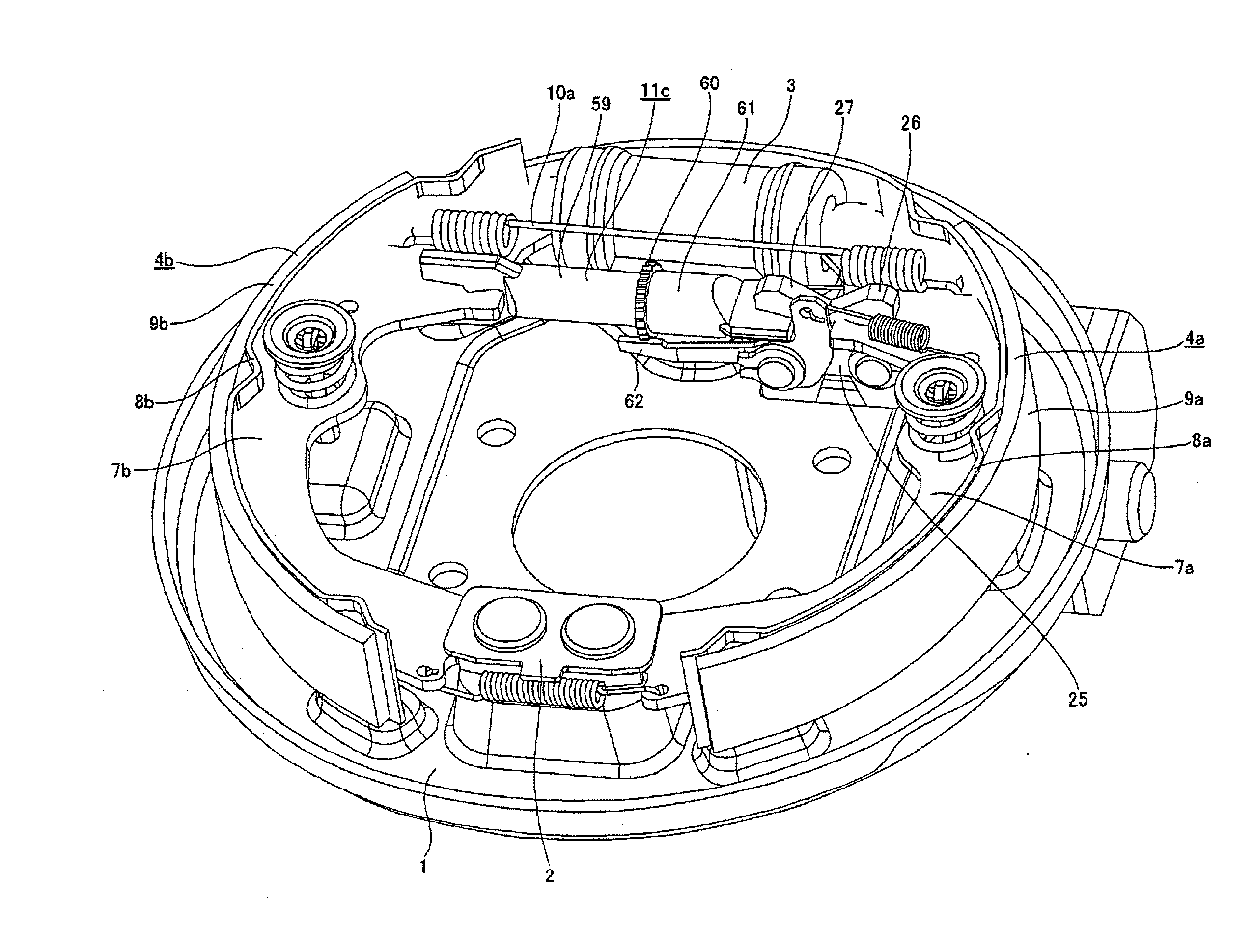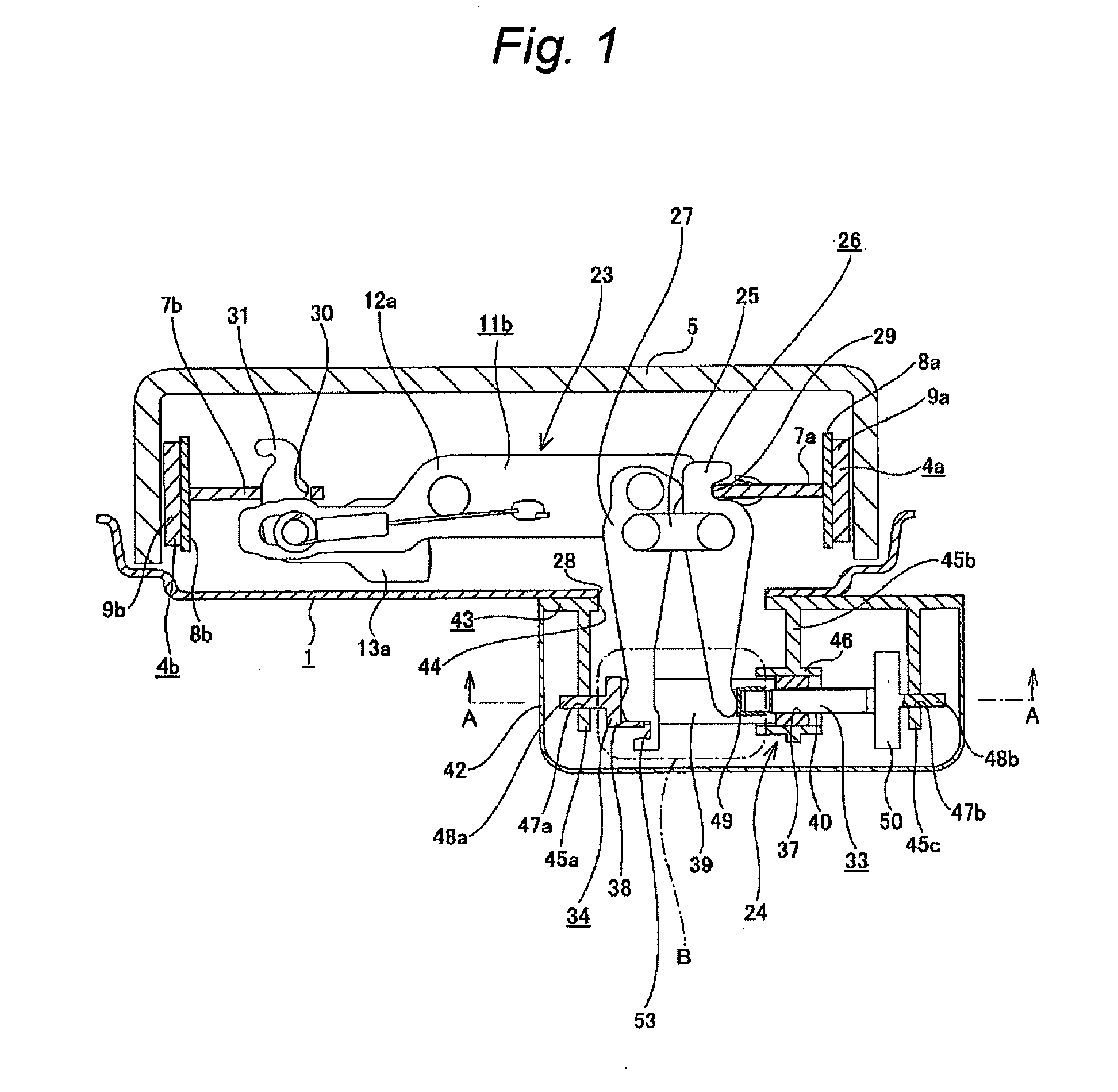Drum brake type parking brake apparatus
a technology of parking brakes and drum brakes, which is applied in mechanical devices, brake systems, transportation and packaging, etc., can solve the problems of reducing the size and weight of the drum brake type of parking brake apparatus, and achieves the effects of small output, reduced size and weight, and low transmission loss
- Summary
- Abstract
- Description
- Claims
- Application Information
AI Technical Summary
Benefits of technology
Problems solved by technology
Method used
Image
Examples
first example of embodiment
[0077]FIGS. 1 to 5 show a first example of an embodiment of the present invention corresponding to first to third, fifth and sixth inventions. Furthermore, a characteristic of the present invention including the present embodiment is a structure of a parking brake apparatus for a drum brake. Since a structure and an operation of a drum brake main body portion other than the parking brake device is identical to a leading and trailing type of drum brake widely known from the related art including the structure of the related art shown in aforementioned FIGS. 15 to 20, the illustrations and description relating to the identical portions will be omitted or simplified. Hereinafter, characteristic portions of the present invention will be preponderantly described.
[0078]An expansion and contraction device 23 for expanding and contracting a gap between a pair of brake shoes 4a and 4b is provided between inner peripheral edges of webs 7a and 7b constituting both of the brake shoes 4a and 4b,...
second example of embodiment
[0099]FIGS. 6 to 9 show a second example of an embodiment of the present invention corresponding to the first, fourth and fifth inventions. In the case of the present example, the first and second pressing members, which mutually clamp and press the proximal end portions of the first and second expansion levers 26 and 27 from the opposite sides, are a cover 42a fixed to the back plate 1, and a screw lever 54 supported in the cover 42a so as to be oscillatable only in the axial direction. Furthermore, the screw lever 54 is screwed into a screw hole 56 provided in a central portion of a deceleration rotation member 55 such as a large deceleration gear and a large deceleration pulley rotatably supported in the cover 42a. Furthermore, the deceleration rotation member 55 is freely rotated and driven via a belt 57 or a gear row by means of the electric motor constituting a driving source. Moreover, the proximal end portions of the first and second expansion levers 26 and 27 are mutually s...
third example of embodiment
[0102]FIGS. 10 and 11 show a third example of an embodiment of the present invention corresponding to the first to third, fifth and sixth inventions. In the case of the present example, in contrast to the case of the first example of the aforementioned embodiment, the female screw portion 37a is provided on the side of the second pressing member 33a, the male screw portion 40a is provided on the side of the first pressing member 34a, respectively, and both of the screw portions 37a and 40a are screwed into each other. Moreover, in order to mutually clamp the proximal end portions of the first and second expansion levers 26a and 27a from opposite sides and enable the proximal end portions to be pressed by both of the pressing member 33a and 34a, pressing target plate portions 64a and 64b are provided in the side edge portions of the portions near the proximal ends of both expansion levers 26a and 27a, respectively. Both of the pressing target plate portions 64a and 64b are formed by ...
PUM
 Login to View More
Login to View More Abstract
Description
Claims
Application Information
 Login to View More
Login to View More - R&D
- Intellectual Property
- Life Sciences
- Materials
- Tech Scout
- Unparalleled Data Quality
- Higher Quality Content
- 60% Fewer Hallucinations
Browse by: Latest US Patents, China's latest patents, Technical Efficacy Thesaurus, Application Domain, Technology Topic, Popular Technical Reports.
© 2025 PatSnap. All rights reserved.Legal|Privacy policy|Modern Slavery Act Transparency Statement|Sitemap|About US| Contact US: help@patsnap.com



